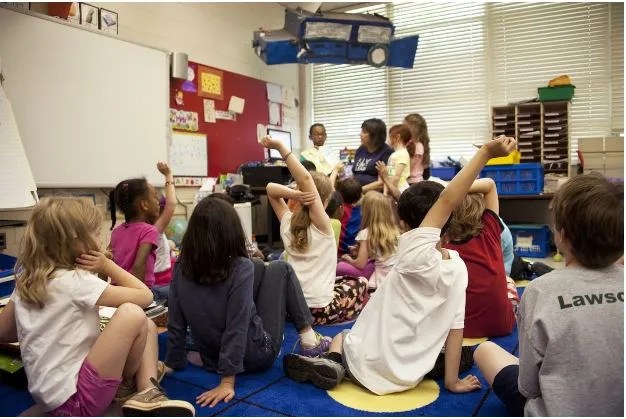
As teachers and parents, we all want to provide the best classroom experience possible for our students. A great way to ensure this is by designing classrooms with thoughtful consideration of furniture arrangement, décor choices, and technology implementation.
In this blog post, we will explore some tips on creating an inspiring learning space for your students so they are engaged in their studies and feel comfortable in their school environment.
Image source: https://unsplash.com/photos/gsRi9cWCIB0
Use ergonomic furniture
In today’s fast-paced world, comfort and safety are paramount, even at school. It’s no secret that sitting for long periods can be a pain in the neck – literally! This is where ergonomic furniture comes in, with a wide array of classroom chairs designed to prevent discomfort and injuries associated with prolonged sitting. Ergonomic chairs reduce pressure on the spine, promote good posture, and improve blood circulation, among other benefits.
Thanks to this investment, students can stay focused and comfortable throughout long study sessions, while teachers can rest easy knowing that their students are well-supported. After all, healthy students make better learners! So, make the switch to ergonomic furniture and experience the difference it can make.
Choose the right lighting
Creating an optimal learning environment is essential for students and professionals alike. Lighting plays a crucial role in the overall learning experience since it can impact anyone’s concentration, mood, and productivity.
When choosing the right lighting, there are a few key factors to keep in mind:
- The intensity of the light should match the task at hand – for example, reading requires brighter light than sitting in a meeting.
- The color temperature of the light influences the mood and energy level of those in the room.
- Natural light is often the best option, as it provides a sense of connection to the outside world and combat fatigue.
Create a color scheme that is both stimulating and calming
Color schemes have the power to communicate a wide range of emotions. For this reason, it’s important to find the right balance between warm and cool tones. Using warm colors like reds, oranges, and yellows can add excitement and energy, while cooler colors like blues and greens can evoke a sense of relaxation and calmness.
Consider using a complementary color palette, think of blue and orange as an example, to create a dynamic yet harmonious effect. We also suggest incorporating neutral tones like grays and beiges to balance out the bright hues. By experimenting with different combinations, you can create a color scheme that looks appealing and engages the senses in both stimulating and calming ways.
Incorporate technology into the classroom design
As education is constantly evolving, the traditional classroom design is evolving too. With the advancement of technology, schools are seeking to incorporate it into the classroom to enhance the learning experience.
From interactive whiteboards to personalized tablets, the potential for technology to engage and motivate students is limitless. Apart from improving the way students learn, it boosts the way teachers teach, allowing them to focus on individual needs and undertake more interactive lessons. The incorporation of technology into the classroom design represents an exciting change in the world of education that promises to keep students engaged and on the cutting edge of progress.
Utilize soundproofing materials
The classroom is meant to be a place of productivity and learning, but with the constant noise and distractions, it can be a challenging environment to focus in. But, there is one solution that could help students and teachers alike to get some peace and quiet — soundproofing materials.
These materials can have a significant impact on reducing noise levels and creating an environment that is conducive to learning. Whether it’s soundproofing panels, acoustic insulation, or floor underlayment, there are various options available to choose from. With the help of these materials, the classroom can transform into a space that fosters productivity and enables students to excel in their studies.
Incorporate natural elements
Classroom design has come a long way over the years, with many educators recognizing the importance of creating a calming and inspiring environment that is conducive to learning. Start by incorporating natural elements into the space — plants, natural light, or wooden features. You’re sure these elements can all create a calming atmosphere that encourages students to focus and engage with their studies. Not only that, but research has shown that being in nature can have a positive impact on mental health, so by bringing a little bit of the outside into the classroom, we can help to support our students in many different ways.
Reduce the “Teaching Footprint”
As a teacher, you should consider your impact on the environment and find ways to reduce your “teaching footprint.” One area to focus on is your classroom. And here are some tips on how to do it:
- Turn off lights and electronics when not in use
- Reduce paper use through digital assignments and notes
- Use energy-efficient appliances
- Switch to LED bulbs
- Encourage the use of reusable water bottles and mugs
By implementing these simple changes, you can reduce your classroom’s environmental footprint and make sure that we’re all doing our part in protecting our planet.
Give space for collaboration
Creating a collaborative environment is essential in a classroom setting. By giving students space to work together, they can learn from one another and develop important social skills. Collaboration promotes active learning and allows students to explore their own ideas and perspectives.
Teachers can encourage collaboration in a variety of ways, especially through group projects or classroom discussions. When students work together, they are able to learn from their peers and gain valuable insights into different perspectives.

Image source: https://unsplash.com/photos/4nKOEAQaTgA
As educators, we want to do everything we can to create an optimal learning environment in the classroom. While classroom design has long been a static affair, utilizing the current trends of ergonomic office furniture, color schemes, and ‘teaching footprint’ reduction can make drastic improvements.
With soundproofing materials and natural elements alongside innovative technology, it’s possible to create a collaborative and inviting learning atmosphere where students are free to excel without being hindered by their environment.
In short, today’s classroom must be designed with more than just desks and chairs in mind; its design should have both practicality and aesthetics in order to enable true learning.




